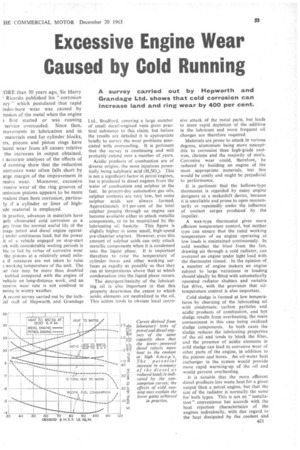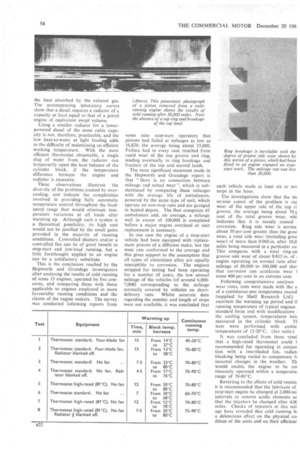Excessive Engine Wear Caused by Cold Running
Page 55

Page 56

If you've noticed an error in this article please click here to report it so we can fix it.
A survey carried out by Hepworth and Grandage Ltd. shows that cold corrosion can increase land and ring wear by 400 per cent. [ORE than 30 years ago, Sir Harry Ricardo published his "corrosion ory " which postulated that rapid inder-bore wear was caused by rosion of the metal when the engine s first started or was running service overcooled. Since then, 3rovements in lubrication and in materials used for cylinder blocks, ,rs, pistons and piston rings have Euced wear from all causes relative the increases in output obtained, accurate analyses of the effects of
d running show that the reduction corrosive wear often falls short by arge margin of the improvement in rasiv e wear. Moreover, excessive -rosive wear of the ring grooves of [minium pistons appears to be more walent than bore corrosion, particuly if a cylinder or liner of hightde material is employed.
In practice, advances in materials have gely eliminated cold corrosion as a gey from the normal useful life of the !rage petrol and diesel engine operat; under continuous load, but the power it of a vehicle engaged on stop-start irk with considerable waiting periods is ble to fail by virtue of corrosive wear the pistons at a relatively small mile e if measures are not taken to raise ! working temperature of the unit. The :ar rate may be more than doubled
trebled compared with the engine of vehicle on long-distance work, and an cessive wear rate is not confined to nning in wintry weather.
A recent survey carried out by the tech:al gaff of Hepworth and Grandage Ltd., Bradford. covering a large number of small diesel-engined vans gives practical substance to this claim, but before the results are detailed it is appropriate briefly to survey the wear problems associated with overcooling. It is pertinent that the survey is continuing and will probably extend over a number of years.
Acidic products of combustion are of diverse origins, the most injurious potentially being sulphuric acid (H,SO4). This is not a significant factor in petrol engines, but is produced in diesel engines from the water of combustion and sulphur in the fuel. In present-day automotive gas oils, sulphur contents are very low, but some sulphur acids are always formed. Approximately 0.1 per cent of the total sulphur passing through an engine can become available either to attack metallic components, or to be neutralized by the lubricating oil basicity. This figure is slightly higher in some small, high-speed pre-chamber engines. However, even this amount of sulphur acids can only attack metallic components when it is condensed into the liquid phase, It is important therefore to raise the temperature of cylinder bores and other working surfaces as rapidly as possible so that they run at temperatures above that at which condensation into the liquid phase occurs.
The detergent/basicity of the lubricating oil is also important in that this property determines the extent to which acidic elements are neutralized in the oil. This action tends to obviate local corro
sive attack of the metal parts, but leads to more rapid depletion of the additive in the lubricant and more frequent oil changes are therefore required.
Materials are prone to attack in various degrees, aluminium being more susceptible to corrosion than high-grade castiron, chrome and the majority of steels. Corrosive wear could, therefore, be reduced by building an engine of the most appropriate materials, but this would be costly and might be prejudicial to performance.
It is pertinent that the bellows-type thermostat is regarded by many engine designers as a makeshift device, because it is unreliable and prone to open momentarily or repeatedly under the influence of coolant surges produced by the impeller.
A wax-type thermostat gives more efficient temperature control, but neither type can ensure that the rated working temperature of an engine operating at low loads is maintained continuously. In cold weather the blast from the fan, drawing air through a cold radiator, can overcool an engine under light load with the thermostat closed. In the opinion of a, number of engine makers an engine subject to large variations in loading should ideally be fitted with automatically operated radiator shutters and variable fan drive, with the provision that oiltemperature control is also important.
Cold sludge is formed at low temperatures by churning of the lubricating oil with condensate, carbon particles and acidic products of combustion, and hot sludge results from overheating, the main contaminant in this case being oxidized sludge components. In both cases the sludge reduces the lubricating properties of the oil and tends to block the filter, and the presence of acidic elements in cold sludge can lead to corrosive wear of other parts of the engine, in addition to the pistons and bores. An oil-water heat exchanger in the system would provide more rapid warming-up of the oil and would prevent overheating.
It is notable that the more efficient diesel produces less waste heat for a given output than a petrol engine, but that the size of the radiator is normally the same for both types. This is not an " installation " convenience but accords with the heat rejection characteristics of the engines individually, with due regard to the heat dissipated by the coolant arid
the heat absorbed by the exhaust gas. The accompanying laboratory curves show that a diesel requires a radiator of a capacity at least equal to that of a petrol engine of equivalent swept volume.
Using a smaller radiator for a lowerpowered diesel of the same cubic capacity is not, therefore, practicable, and the low heat-to-water at light loading adds to the difficulty of maintaining an efficient working temperature. With the most efficient thermostat obtainable, a single slug of water from the radiator can temporarily upset the heat balance of the cylinder block, if the temperature difference between the engine and radiator is excessive.
These observations illustrate the diversity of the problems created by overcooling, and indicate the complexities involved in providing fully automatic temperature control throughout the loadspeed range that would eliminate temperature variations at all loads after warming up. Although such a system is a theoretical possibility, its high cost would not be justified by the small gains provided in the majority of running conditions. Controlled shutters and/or a controlled fan can be of great benefit in stop-start and low-load running, but a little forethought applied to an engine can be a satisfactory substitute.
This is the conclusion reached by the Hepworth and Grandage investigators after analysing the results of cold running of some 15 engines, operated by five concerns, and comparing them with those applicable to engines employed in more favourable running conditions and the claims of the engine makers. The survey was conducted following reports from some nine stop-start operators that pistons had failed at mileages as low as 16,820, the average being about 35,000. Failure had in every case resulted from rapid wear of the top groove and ring, leading eventually to ring breakage and fracture of the top and second lands.
The most significant statement made in the Hepworth and Grandage report is that "there is no connection between mileage and actual wear ", which is substantiated by comparing these mileages with the average life of ambulances, powered by the same type of unit, which operate on non-stop runs and are garaged in heated depots. The fleet comprises 45 ambulances arid, on average, a mileage well in excess of 100,000 is completed before a major engine overhaul or unit replacement is necessary.
In one case the engine of a stop-start vehicle had been equipped with replacement pistons of a different make, but the wear rate conformed to the average and this gives support to the assumption that all types of aluminium alloy are equally susceptible to corrosion. The engines stripped for testing had been operating for a number of years, the low annual mileage of the vehicles (of around 6,0007,000) corresponding to the mileage normally covered by vehicles on shortdelivery runs. Whilst accurate data regarding the number and length of stops were not available, it was concluded that each vehicle made at least six or see stops in the hour.
The investigations show that the im serious aspect of the problem is rar wear of the upper side of the top ri groove, the average being about 70 cent of the total groove wear. whi indicates that it is mainly caused corrosion. Ring side wear is norma about 50 per cent greater than the groo wear, a total side wear (including groo wear) of more than 0.060 in. after 10,0 miles being measured in a particular ca; This compares with a total ring-an groove side wear of about 0.015 in. of ; engine operating on normal runs after mileage of 80,000 to 100,000 and shol that corrosion can accelerate. wear I some 400 per cent in an extreme case.
Following comprehensive analyses wear rates, tests were made with the a of a continuous-pen temperature record (supplied by Shell Research Ltd.) ascertain the warming up period and II running temperature of typical engines standard form and with modifications the cooling system, temperatures belt measured in the cylinder block. TI tests were performed with ambie temperatures of 12-20°C. (See table.) It was concluded from these resul that a high-rated thermostat could I recommended for operating in conjun tion with a two-bladed fan, radiati blanking being varied to compensate 14 seasonal changes in the weather. Th would enable the engine to be col tinuously operated within a temperatu; range of 70-80°C.
Reverting to the effects of cold runnin it is recommended that the lubricant of stop-start engine be changed at 2,000-mi intervals to remove acidic elements at that the injectors be changed after 4,0( miles. Checks of injectors at this mil age have revealed that cold running h; a deleterious effect on the physical co; dition of the units and on their efficienc




























































































